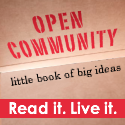 Unless you’ve been living under a rock, social media divas Lindy Dreyer and Maddie Grant, CAE of SocialFish have published their first book, Open Community. The book offers advice to associations looking to either create or expand their online communities with the help of social media. From an advocacy perspective, this is an excellent resource for government relations professionals. I’m so fortunate to have Maddie here to discuss the book and how the open community model applies to government relations.
Unless you’ve been living under a rock, social media divas Lindy Dreyer and Maddie Grant, CAE of SocialFish have published their first book, Open Community. The book offers advice to associations looking to either create or expand their online communities with the help of social media. From an advocacy perspective, this is an excellent resource for government relations professionals. I’m so fortunate to have Maddie here to discuss the book and how the open community model applies to government relations.
Association Advocacy Chick: Congrats on the book! In the months since its release, what type of response have you received?
Maddie Grant: Thanks Stefanie! The response has been really amazing, and fun, with people taking pictures of themselves holding the book as it arrived on their doorsteps, and even one really great video review where a whole team of people each talked about one chapter of the book that resonated with them. Now that the holidays are over and it’s been two months since the release, we’re hoping to read more reviews of the book out there in the blogosphere. We’re also going to focus heavily on finding case studies of each of the different “big ideas” in the book; we’re collecting them for a blog series on our SocialFishing blog, to discuss in future presentations or book club gatherings, and all kinds of cool stuff.
AAC: Open Community is a great resource for government relations professionals. What lessons can GR staff take away from the book?
MG: The whole book is about getting back to the core of what social media is all about for associations – namely achieving the mission of the organization. Obviously, advocacy and government relations are a huge focus for most associations to achieve their mission, so social media is now at the forefront of those efforts. A lot of what we talk about in the book has to do with internal capacity building and infrastructure – how to collaborate internally so departments can help each other, how to develop skill sets among staff for doing the work of building community online – these are all things that will help GR staff along with all other department achieve success in their community building efforts. You have to nurture the community around an organization in order for that community to be there for you when you need them to take collective action.
AAC: There is still some hesitancy in using social media as part of an association’s lobbying strategy. Many still believe it’s a fad or that it doesn’t bring value. What can staff and members do to tackle this issue?
MG: The very first step is always listening – meaning figuring out where stakeholders are out there on the social web. This kind of listening can and should take many forms for an organization – our example in the book is “eight people at a dinner party will different conversations swirling around the table, just like eight people setting up Google alerts will get different results based on the keywords they choose – and that’s a good thing.” So for GR people specifically, your stakeholders in this particular case may be various members of Congress – and you need to know if the people you want to reach are already talking to their constituents online. And we know there are a LOT of Members of Congress on social networks (see here, and here, and here, and here.) So once you know where they are, how do you start connecting with them? Well you have to be in it to win it, so to speak. 🙂
AAC: There’s no better example of open community for government relations than with grassroots advocacy. A typical grassroots list is maintained online and consists of those who expressed interest in contacting their Members of Congress. However, that usually leaves a large portion of the membership out in the universe who are not engaged. How can the concepts in Open Community be used to help bring them into the fold?
MG: The beauty of a truly thriving open community has to do with its openness (well, duh!) and its messiness. What that means is that through the magic of Google, anyone can see what an associations’ advocacy efforts are (for example) – so an organization can fire up the hearts and minds of members and others who care about the industry or cause through the sharing of conversation and information about that mission. The key to all of this though is that what rises to the top (literally, in terms of search results) is people who are energized and enthusiastic and talking about the issues – and it’s those people who can attract other people. It’s member to member evangelism – not broadcasting from staff. But staff who understand community can participate as equals. They can also point to those energizing conversations when they are educating the wider membership about what’s going on. They can make everything come alive for members who might not otherwise feel engaged. They can help nurture a community where everyone wants to be a part of it.
To learn more about Open Community or to purchase your copy, please visit its page on the SocialFish website: http://www.socialfish.org/open-community
